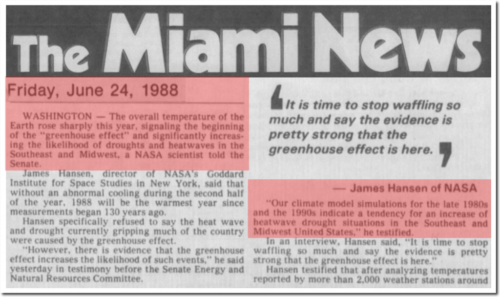 Various climate scientists took issue with our editorial on climate change that highlighted a new study regarding nitrogen in rocks, saying it misrepresented the study. (See A Startling New Discovery Could Destroy All Those Global Warming Doomsday Forecasts.)
Various climate scientists took issue with our editorial on climate change that highlighted a new study regarding nitrogen in rocks, saying it misrepresented the study. (See A Startling New Discovery Could Destroy All Those Global Warming Doomsday Forecasts.)
The criticism appears on Climate Feedback, a website that has taken it upon itself to critique news and commentary on global warming issues.
But right off the bat, the “fact check” misrepresents what we said. The Climate Feedback headline reads: “Investor’s Business Daily editorial misrepresents study to claim plants will prevent dangerous climate change.”
That’s not what we said at all. The headline in our editorial says the study “could” render doomsday forecasts obsolete. There’s an important distinction between “could” and “will.” And we weren’t referring to “dangerous climate change” — whatever that means — but the end-of-the-world predictions that climate scientists have been making for decades. Thus, the word “doomsday.”
Nevertheless, the conclusion of the scientists who read our editorial was that it lacked scientific credibility, was derogatory, used flawed reasoning, and was misleading, even though the article quoted scientists throughout.
The main argument appears to be that we exaggerated the importance of the study’s findings and didn’t understand the role nitrogen plays in climate-change scenarios.
But it wasn’t us playing up the importance of the nitrogen study. We quoted Ronald Amundson, a soil biogeochemist at the University of California at Berkeley, who told Chemical and Engineering News that “If there is more nitrogen there than expected, then the constraints on plant growth in a high-CO2 world may not be as great as we think.”
In one of the responses to our editorial, the author of the study at the heart of it, Benjamin Houlton, says that he believes climate change is an urgent problem and that his findings don’t relieve the world of having to tackle the problem.
Fair enough. But it was Houlton’s own words about his findings — that it “runs counter to the centuries-long paradigm that has laid the foundation for the environmental sciences” — that led us to conclude this was a big deal.
Another complaint is that we say the findings about nitrogen in rocks isn’t news. Maynooth University Professor Peter Thorne, for example, says “That the rocks in the crust of the planet contain nitrogen has been known for in excess of a century.”
Again, it was Houlton who made the claim that this was a breakthrough finding, not us. If he’s guilty of exaggerating the importance of his research, that’s hardly our fault.
Then there’s the criticism from Kerry Emanuel, professor of Atmospheric Science at MIT. He complained about a line in the editorial that said: “Nor have various calamities that were supposed to have occurred by now materialized.”
To that, Emanuel replied: “We predicted, 31 years ago, that hurricane intensity would increase with greenhouse-gas concentrations. In 2013, Typhoon Haiyan set the world-record wind speed in a landfalling tropical cyclone, and in 2015 eastern North Pacific Hurricane Patricia set an all-time record for hurricane winds. Hurricane Irma of 2017 maintained Category 5 status for longer than any storm on record. Do tell the residents of Tacloban, Puerto Rico, and the Virgin Islands that they have not experienced calamities.”
Let’s look closely at this response.
Emanuel is asserting that climate scientists have been absolutely right about greenhouse gases and hurricane intensity because there have been three hurricanes that set records for wind speed in recent years.
Leave aside the fact that “world records” in this case only go back so far, since mankind wasn’t measuring the wind speeds of hurricanes until relatively recently. It’s possible that there were many far stronger hurricanes before measurements began.

 The more important data would, it seems to us, be the overall trend in hurricane intensity.
The more important data would, it seems to us, be the overall trend in hurricane intensity.
As it happens, the National Oceanic and Atmospheric Administration has been measuring this — it’s called the Accumulated Cyclone Energy Index — in both the Atlantic and Pacific. Here are charts reproduced directly from its website.
Does anyone see any discernible upward trendline over the past four decades in hurricane intensity as greenhouse-gas concentrations increased?
In fact, the ACE Indexes for 2013, the year of Typhoon Haiyan that Emanuel cites as proof that climate scientists are right, was well below average.
We found the same thing when it came to other natural disasters climate scientists have been telling us would increase in frequency and severity as the planet warmed. There’s been no trend in droughts, snow cover, wildfires or tornadoes in the U.S.
Yet Emanuel ignores these broader sets of data to focus on just three events. Why? We’re not scientists, but we’re pretty sure this isn’t how the scientific method is supposed to work. After all, it’s a bit like saying that a soothsayer is credible because she occasionally guesses future events correctly.
At the end of his critique, Emanuel makes a snide suggestion that we’re indifferent to the suffering of people hurt by natural disasters.
So, it would appear that the fact-checking climate experts did just what they accused us of doing, with criticisms that were misleading, used flawed reasoning and were derogatory.
Is it any wonder people are skeptical of climate science these days?
Read more at IBD

















Trying to blame last years Hurricanes on Global Warming/Climate Change is just as idiotic blaming so called witches for the Black death that hit europe in the 1500 its just liberals just looking for scapegoats